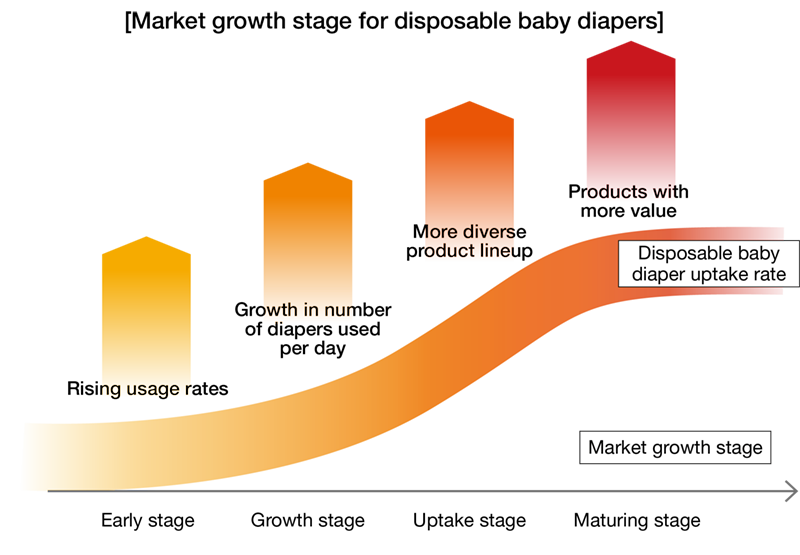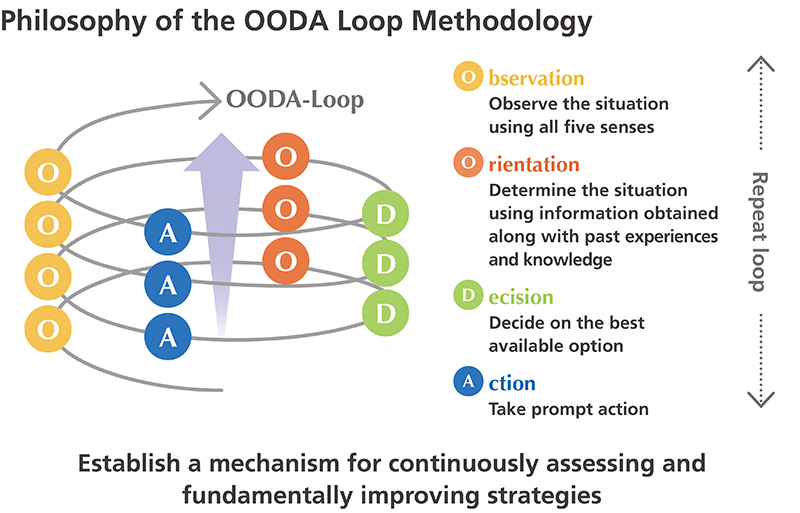A Quick Guide to Unicharm
(Chapter 2: Strengths that support Unicharm’s sustained growth)
Strengths that support Unicharm’s sustained growth
Evolution of our “winning patterns”


The popularity of Unicharm products in many consumer markets around the world reflects our efforts to develop products tailored to the cultures and living environments of each country and region, backed by detailed research into local lifestyles and consumption habits. At the same time, we have been working to distribute our products to as many retailers as possible and communicating the value of our product range to the fullest by working with retailers to create shopper-focused sales areas using digital technology.
To remain competitive amid rapid advances in IT and globalization, we have to think and act faster.
Using a dynamic cycle of trial and error, we will adjust our “winning patterns” to match changes in the operating environment and transfer them to overseas markets.
Implementing strategies for each phase of market growth


Unicharm implements clear strategies tailored to each stage of market growth: early stage, growth stage, uptake stage and mature stage. Based on careful analysis of these growth phases, we work to boost market uptake and maximize profts by launching the right products at the right time in each market.
There is a close correlation between market uptake rates for nonwoven fabric and absorbent material products and per capita GDP in each country. Our research shows that uptake rates for feminine care products and disposable baby diapers jump sharply when per capita GDP exceeds $3,000. When per capita GDP rises to a high level, uptake for feminine care products and disposable baby diapers reaches a ceiling, but market uptake increases for disposable adult diapers and pet care products. Demand for feminine care products and disposable baby diapers is currently growing across many emerging markets in Asia, Africa and South America. Going forward, we also anticipate rising demand for disposable adult diapers and pet care products in Asia, as well as in advanced markets. In addition, in countries and regions where there is poor understanding about menstruation and a lack of social infrastructure, we are working with governments and local NGOs to help women play a greater role in society.
Those efforts also help to increase recognition of the Unicharm name overseas and improve our brand image.
Implementing our strategies using “Management with Resonance” – close cooperation between management and frontline employees


Unicharm implements management with resonance, its unique management model, through each of its Group employees. Management with resonance is a management methodology that facilitates the growth of every employee, and in turn the growth of Unicharm as a whole, by arming people in management positions with unfiltered information from frontline employees and making frontline employees aware of management’s perspectives, outlooks, and targets.
By implementing management with resonance, we aim to develop personnel who can identify issues on their own initiative, determine how to address these issues, and work continuously until they are resolved. We call employees who demonstrate such a mindset and behavioral traits “resonant personnel,” which is how we define our ideal human resources.
To promote management with resonance “moves ahead while thinking”


Since 2003, Unicharm has been operating the Schedule–Action–Performance–Schedule (SAPS) management model, through which employees work to achieve goals using their own initiative by actively operating a Plan–Do–Check–Act (PDCA) cycle, enhancing the strength of both employees and the organization. However, in the current “new normal” environment, where the business landscape is constantly changing, it became necessary to establish a model that flexibly accommodates these changes. Recognizing this need, we replaced the SAPS management model with the Observe–Orient–Decide–Act Loop (OODA Loop) methodology in 2019.
With the OODA Loop methodology, we quickly grasp unexpected changes by observing current business conditions, appropriately orient ourselves to the situation, reach a decision, and then take action. We repeat this cycle while constantly reviewing approaches and making fundamental changes. The OODA Loop methodology enables our employees to respond quickly to changes in the business environment,orient themselves to the situation, make decisions, and take actions that lead to results.
